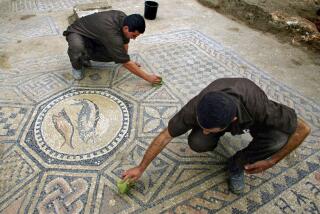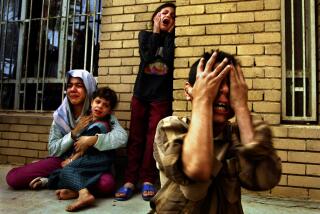Authentic Isn’t the Word for Iraq’s New Babylon : Mideast: Since 1978, Saddam Hussein has been restoring the city his way. Experts haven’t exactly raved.
- Share via
BABYLON, Iraq — Over the millennia, many calamities have struck this cradle of civilization, site of the Tower of Babel and the Hanging Gardens, one of the Seven Wonders of the World.
Among the worst occurred in 538 BC, when Babylon fell to elephant-riding Persian imperialists and 200 years of decay set in.
Some experts say the most recent was when Iraqi President Saddam Hussein set out to re-create ancient Babylon--in his own image.
Under his reign, a new Babylon is rising.
But it is hardly one that Hammurabi or Nebuchadnezzar would recognize.
The Euphrates River, which once bisected the square inner core of Babylon, long ago changed course and now lies well to the west. But no problem. It’s been replaced here by a plain concrete ditch. Filled with shallow, murky water, the New Euphrates River of Hussein’s Babylon looks like a miniature Los Angeles River.
Nearby, a new Ishtar Gate, barely half the size of the original, now stands, decorated with friezes of bulls, dragons and lions in enameled, colored brick. The effect is decidedly more Disneyland than Mesopotamia.
And what remains of a broad boulevard known as Procession Street is now barely discernible--as a narrow dirt path overgrown with weeds. Instead, a new stone path leads up to the garish Ishtar Gate.
Inside the gate, over the crumbled remains of Babylon’s original double row of defensive walls, the Iraqis have put up new walls, perhaps 60 feet tall or higher. The neatly cut bricks are bright yellow--and were clearly mass-produced in a modern factory.
Each brick bears Hussein’s name.
“Tourism being what it is, I suppose it was a natural desire to have something there for visitors to see,” lamented one U.S. archeologist who specializes in the Middle East.
*
Actually, the first indications that little remains of old Babylon--and the extent to which the present now intrudes upon the past--emerge well before one reaches Babylon, about 60 miles south of Baghdad.
No matter what direction one approaches the city from, it is impossible to miss the bigger-than-life billboards of Hussein, the new guardian of Babylon.
“The cult of personality reached its zenith in the restoration of ancient Babylon, where Saddam Hussein tied himself to the greatness of Nebuchadnezzar,” author Sandra Mackey rues in her latest book on the Middle East, “Passion and Politics: The Turbulent World of the Arabs.”
It was under Nebuchadnezzar II that Babylon attained its greatest glory. This ancient city goes back at least 2,400 years before Christ. At its height (605-563 BC), Babylon was regarded as one of the most beautiful cities in the world.
It was here in the Fertile Crescent that mankind first turned from hunting and gathering to agriculture and began using the seven-day week, based on a 24-hour day. Clay tablets reveal an economic life of amazing complexity for its day, including installment-buying.
But the current restoration of Babylon, begun in 1978 and interrupted by a sweeping international trade embargo against Iraq following its 1990 invasion of Kuwait, is receiving mixed reviews from experts on Middle East archeology.
In an interview, one noted professor of Near East archeology expressed deep disappointment; he asked not to be named, saying he did not want to incur Iraqi wrath because he hopes to be invited back.
But Prudence Harper, curator of the Ancient Near Eastern Art Department at New York’s Metropolitan Museum, was less oblique. “Yes, he’s stamped the bricks with his name. But that’s all right. The Babylonians stamped them with their names too,” she said.
“But there has been a lot of modern reconstruction,” she said.
*
The deterioration of Babylon--and its crass modernization--seem symptomatic of a larger mind-set throughout Iraq, the home, after all, of perhaps more sites that reveal the story of ancient civilization than any other nation.
Near the southern port of Basra, an oil refinery now occupies the possible location of the Garden of Eden; a suspected onetime chemical-warfare plant sits near the tomb of Jonah; a military air base lies near Ur, the birthplace of Abraham.
But nowhere is the collision of old and new more jarring than in Babylon.
Aside from the reconstructed Ishtar Gate, the new double walls and a few temples and other replicas, the site is little more than a vast expanse of arid mounds and hills, occasionally dotted by the crumbling remains of original brickwork.
The place is eerily still under the hot sun. On a tour one recent afternoon, a visitor saw no other tourists. And the Nebuchadnezzar Museum was padlocked--until a gift-store owner shuffled over to open the heavy wooden doors.
“It’s the sanctions,” the merchant said dismissively, referring to the economic sanctions, which include a ban on air traffic into and out of Iraq. Later, a busload of bedraggled Jordanians arrived to tour Babylon.
Despite the paucity of visitors, the site is strewn with a surprising amount of trash--and even some graffiti.
One of the few remaining ancient relics is a magnificent larger-than-life lion made out of basalt. But it too has been eroded by time and weather.
That so little remains of old Babylon can be blamed, in part, on the corrosive effect of the harsh desert climate on unbaked clay, the prime building material here.
“Mud brick tends to melt in the rain and winds,” said David Stronach, professor of Near East archeology at UC Berkeley.
“With unbaked clay,” Harper added, “you’re lucky to have anything left above ground. We’re not dealing with a stone culture here.”
Over time, residents also have freely carted away the mud and clay bricks for construction material. The nearby town of Hillah, for instance, was built largely with the bricks of Babylon, experts said.
The extensive rebuilding during the reign of Nebuchadnezzar II also left little archeological data from earlier than that time. And the high water table here has further limited excavation.
Finally, much of what remained was taken by European archeologists who worked here earlier in this century. For instance, it was here that French archeologists in 1901 discovered the massive stones on which Hammurabi inscribed his famous code of law in the 18th Century BC.
The stones now repose in the Louvre.
Still, the importance of the site cannot be underestimated, experts say.
“To archeologists, there’s still an impressive amount of standing material left at that site. But I can understand the disappointment of the average tourist upon seeing Babylon,” Harper said. “If you want to see the real thing, you’d have to go to Berlin.”
More to Read
Sign up for Essential California
The most important California stories and recommendations in your inbox every morning.
You may occasionally receive promotional content from the Los Angeles Times.













